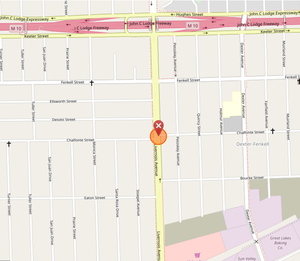Livernois–Fenkell riot: Difference between revisions
No edit summary Tag: Reverted |
No edit summary Tag: Reverted |
||
| Line 62: | Line 62: | ||
[[Category:African-American riots in the United States]] |
[[Category:African-American riots in the United States]] |
||
[[Category:Riots and civil disorder in Detroit]] |
[[Category:Riots and civil disorder in Detroit]] |
||
[[Category:Lynching deaths in the United States]] |
|||
Revision as of 03:22, 3 December 2022
 Map of the riot location | |
| Date | Friday, August 1, 1975 |
|---|---|
| Location | Livernois Avenue at Chalfonte Avenue, just south of Fenkell Avenue, in Detroit, Michigan |
| Deaths |
|
| Non-fatal injuries | 10 injuries |
The Livernois–Fenkell riot was a racially motivated riot in the summer of 1975 on Livernois Avenue at Chalfonte Avenue, just south of Fenkell Avenue, in Detroit, Michigan.
Riot
The trouble began when Andrew Chinarian, the 39-year-old owner of Bolton's Bar, observed three black youths tampering with his car in the parking lot. He fired a pistol or rifle, fatally wounding 18 year old Obie Wynn.[2] According to some accounts, Wynn was fleeing; according to others, he was approaching Chinarian with what the latter thought was a weapon, it later emerged that Wynn was holding a screwdriver. He died from a gun wound to the back of the head.[3] Crowds gathered and random acts of vandalism, assault looting and racial fighting along Livernois and Fenkell avenues ensued. Bottles and rocks were thrown at passing cars.[3]
The second fatality was Marian Pyszko, a 54-year-old dishwasher and a Nazi concentration-camp survivor who had emigrated from Poland in 1958.[4][incomplete short citation] As he drove home from the bakery/candy-factory where he worked, he was pulled from his car by a group of black youths and beaten to death with a piece of concrete.[5][page needed] Ronald Bell Jordan, Raymond Peoples, and Dennis Lindsay were all charged with first-degree murder.[6]
Police were ordered to avoid the use of deadly force, and indeed, not a shot was fired.[5] The crowd of 700 was dispersed by morning. However, angry crowds and violence reappeared the following night – using a car as a battering ram, the crowd stormed and ransacked Bolton's Bar.[3]
Detroit mayor Coleman Young then worked to defuse the situation by appearing in person, along with numerous clergy, at the scene of the disturbance.[7][incomplete short citation] Another key factor was Mayor Young getting every black policeman in the city to police the riot, further defusing the situation.[7][incomplete short citation]
The damage to property in the Livernois-Fenkell area amounted to tens of thousands of dollars. Fifty-three people were arrested, and ten injuries were recorded (including one firefighter and one police officer). [3]
CBS News reported an unverified claim that the bar served white patrons only, and noted the 25% unemployment rate as an aggravating factor.[8]
See also
- List of riots in Detroit
- List of homicides in Michigan
- List of incidents of civil unrest in the United States
Bibliography
Notes
- ^ Streissguth 2009, p. 115.
- ^ Time 1975.
- ^ a b c d Jet Magazine 1975, p. 7.
- ^ Salpukas 1975, p. 12.
- ^ a b Darden & Thomas 2013.
- ^ Buchanan, Stanford & Kimble 2007, p. 19.
- ^ a b Salpukas 1975, p. 37.
- ^ CBS News 1975.
References
- Buchanan, Heather; Stanford, Sharon; Kimble, Teresa (2007). Eyes on Fire: Witnesses to the Detroit Riot of 1967. Aquarius Press. ISBN 9780971821453. - Total pages: 80
- CBS News (July 29, 1975). "CBS Evening News for Tuesday, July 29, 1975". Vanderbilt Television News Archive. Retrieved August 4, 2019.
- Darden, Joe T.; Thomas, Richard W. (2013). Detroit: Race Riots, Racial Conflicts, and Efforts to Bridge the Racial Divide. Michigan State University Press. ISBN 9781609173524. - Total pages: 325
- Jet Magazine (August 14, 1975). "Violence erupts in Detroit". Jet Magazine. XLVIII (21). Johnson Publishing Company: 6–7. OCLC 20729894. Retrieved August 4, 2019.
- Salpukas, Agis (July 31, 1975a). "Detroit Authorities Move To Keep Unrest in Check". The New York Times. ISSN 1553-8095. OCLC 1645522. Retrieved July 16, 2020.
- Salpukas, Agis (August 1, 1975b). "Symbols of Black Power". The New York Times. New York City. ISSN 1553-8095. OCLC 1645522. Retrieved August 4, 2019.
- Streissguth, Thomas (2009). Hate Crimes. Infobase Publishing. ISBN 9781438119045. - Total pages: 337
- "The Nation: Close to the Brink". Time. August 11, 1975. Retrieved August 4, 2019.
